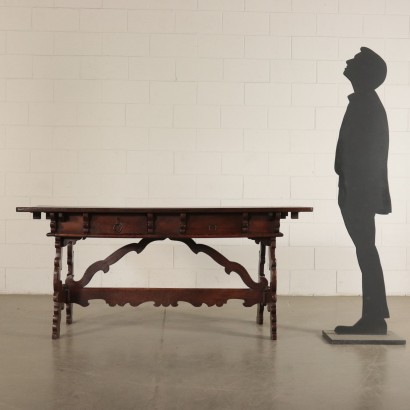Monk's Table Walnut Poplar Silver Italy 18th-20th Century
Features
Age: 18th Century / 1701 - 1800 , 20th Century / 1901 - 2000
Origin: Italy
Main essence: Silver Fir , Various Wood Essences , Walnut , Poplar
Description
Monk's table partially built with old wood. Supported by lyre legs connected by crossbeam and lighthing. Pair of drawers lined up and divided by shaped shelfs. Predisposition for extentions.
Product Condition:
Product in good conditions, shows some signs of wear.
Dimensions (cm):
Height: 79
Width: 175
Depth: 72
Additional Information
Age:
18th Century / 1701 - 1800
18th Century / 1701 - 1800
20th Century / 1901 - 2000
20th Century / 1901 - 2000 Main essence:
Silver Fir
Soft coniferous wood, used for rustic furniture or to build the chest, that is the structure, of furniture then veneered in more precious woods. It has been used since ancient times, its most valuable use is, in the Spruce variant, in the inlays of French antique furniture of the '700 . The spruce, more typical of northern Europe, in Italy grows mainly in the Eastern Alps at altitudes above 1300 m. The noblest use of this essence was in the construction of violins, guitars and cellos: Stradivari himself produced his famous violins with this wood.
Various Wood Essences
Walnut
Walnut wood comes from the plant whose botanical name is juglans regia , probably originally from the East but very common in Europe. Light or dark brown in color, it is a hard wood with a beautiful grain, widely used in antique furniture. It was the main essence in Italy throughout the Renaissance and later had a good diffusion in Europe, especially in England, until the advent of mahogany. It was used for solid wood furniture and sometimes carvings and inlays, its only big limitation is that it suffers a lot from woodworm. In France it was widely used more than anything else in the provinces. In the second half of the eighteenth century its use decreased significantly because mahogany and other exotic woods were preferred.
Poplar
Essence considered "poor", it is a white wood, with yellowish or greyish shades, light and tender, which is easily damaged. It is used for rustic furniture or in the construction of furniture. The most valuable use it has had in the history of furniture is in Germany, in the 19th century, for veneers and inlays in the Biedermeier period. 


























